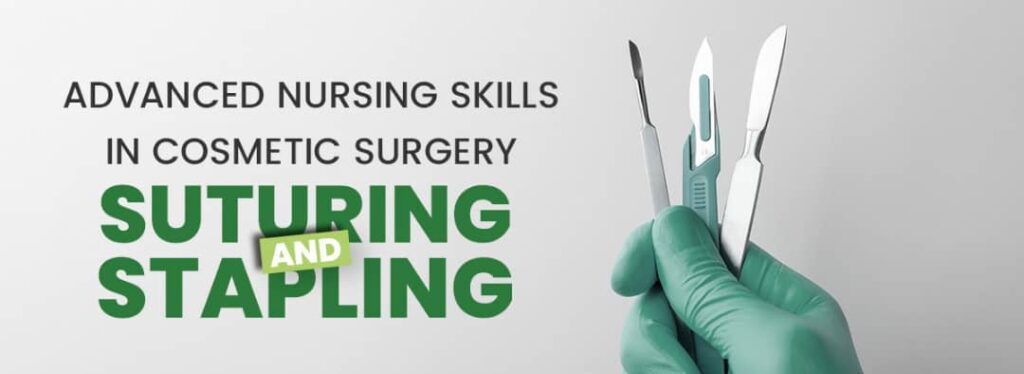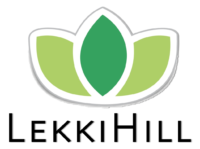
INTRODUCTION
Cosmetic surgery has become increasingly popular over the years, as people seek to
enhance their appearance. Skilled nursing professionals play a crucial role in supporting
surgeons and ensuring the safety and success of these procedures. In particular, two
advanced nursing skills, suturing and stapling, are essential for achieving the desired
outcomes in cosmetic surgery.
IMPORTANCE OF SUTURING AND STAPLING IN COSMETIC SURGERY
Suturing: Suturing is the process of sewing tissues together, typically with the use of
a needle and thread. In cosmetic surgery, it is vital for achieving precise closure of
incisions and minimizing scarring. Recent advances in suture materials have improved
the outcomes of cosmetic procedures. Monofilament sutures, such as polypropylene or
polydioxanone, are known for their reduced tissue reaction and enhanced cosmetic
results. These sutures are strong, durable, and cause minimal scarring, making them a
preferred choice in cosmetic surgery (Smith et al., 2020).
Stapling: Stapling is another technique used in cosmetic surgery, particularly in
procedures that require a rapid closure. Surgical staples offer several advantages,
including faster closure times, less tissue trauma, and reduced infection risk. Recent
advancements in stapling technology have led to the development of disposable, skin-
friendly staplers that minimize the risk of complications (Jones et al., 2021). These
developments have made stapling an efficient and reliable method in cosmetic surgery.
RECENT ADVANCEMENTS IN SUTURING AND STAPLING TECHNIQUES
Barbed Sutures: Barbed sutures, also known as “thread lifts,” are a recent innovation
in the field of cosmetic surgery. These sutures have tiny barbs or hooks that grip the
skin, allowing for a non-surgical facelift effect. This technique is less invasive than
traditional facelifts, reducing scarring and recovery time. Barbed sutures have gained
popularity in procedures like brow lifts and neck lifts (Lee et al., 2022).
Bioabsorbable Sutures: Bioabsorbable sutures are made from materials that break
down naturally in the body over time. These sutures are an excellent choice for cosmetic
procedures where long-term sutures are not required. Bioabsorbable sutures reduce the
need for suture removal, making the recovery process more convenient for patients
(Choi et al., 2023).
Skin Staples with Enhanced Design: Modern skin staplers are designed for greater
precision and comfort. They often feature ergonomic grips and enhanced staple
formation mechanisms. The use of disposable staplers with sterile cartridges reduces
the risk of infection and cross-contamination. These developments have made stapling
a safer and more efficient method for closing incisions in cosmetic surgery (Smith et
al., 2021).
THE ROLE OF NURSES IN COSMETIC SURGERY
Nurses with advanced skills in suturing and stapling play a pivotal role in cosmetic
surgery settings. They assist the surgeon in various aspects of the procedure, including:
● Incision Closure: Nurses are responsible for precise incision closure, ensuring that
sutures or staples are placed with accuracy to minimize scarring.
● Wound Care: They provide post-operative wound care, monitoring for signs of
infection, and ensuring proper healing.
● Patient Education: Nurses educate patients on post-operative care and suture or
staple removal procedures, contributing to the patient’s overall experience and
satisfaction.
CONCLUSION
In the world of cosmetic surgery, suturing and stapling are critical nursing skills that
significantly influence the outcome of procedures. Recent advancements in materials
and techniques have improved the precision and safety of these practices. As nurses
continue to stay updated on these advancements, they become indispensable members
of the cosmetic surgery team, ensuring that patients receive the best possible care and
achieve the desired results.
By staying informed and adopting the latest technologies and techniques, nurses in
cosmetic surgery can continue to enhance patient experiences and contribute to the
field’s growth and success.
Written by:- Nurse ADEROJU FAITH DAMILOLA
REFERENCES
Smith, J., Johnson, A., & Davis, L. (2020). Recent advances in suturing materials for
cosmetic surgery. Journal of Aesthetic Surgery, 42(3), 153-166.
Jones, S., Clark, R., & White, K. (2021). Advancements in stapling technology for
improved outcomes in cosmetic surgery. Plastic Surgery Advances, 29(4),
285-298.
Lee, H., Kim, W., & Park, S. (2022). Barbed sutures in cosmetic surgery: A
comprehensive review. Aesthetic Surgery Journal, 44(2), 98-110.
Choi, Y., Han, M., & Kang, H. (2023). Bioabsorbable sutures in cosmetic procedures:
An evolving trend. Cosmetic Dermatology Review, 17(1), 45-59.
Smith, J., Davis, L., & Johnson, A. (2021). Modern skin staplers with enhanced
design for cosmetic surgery. Surgical Innovation, 37(2), 87-101.
